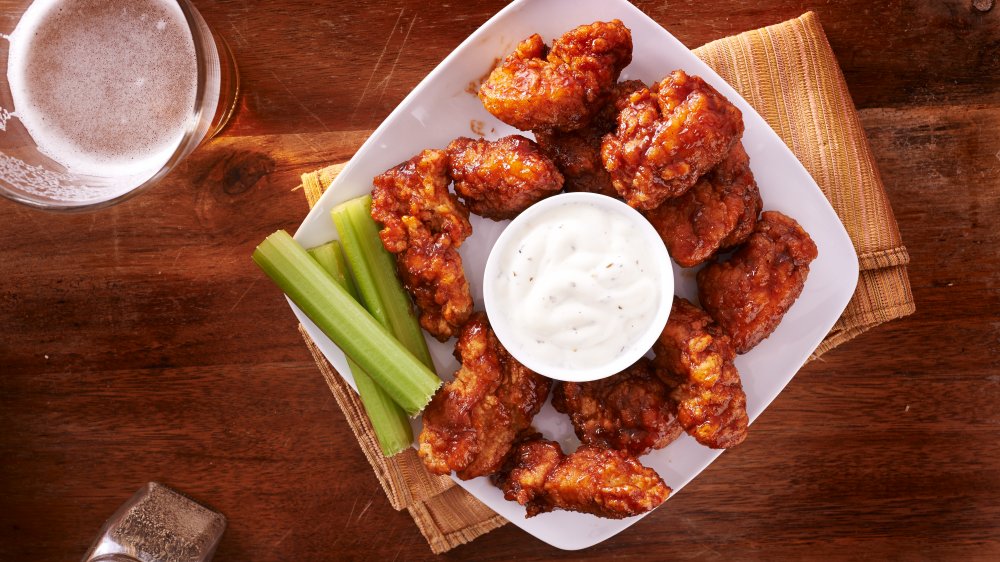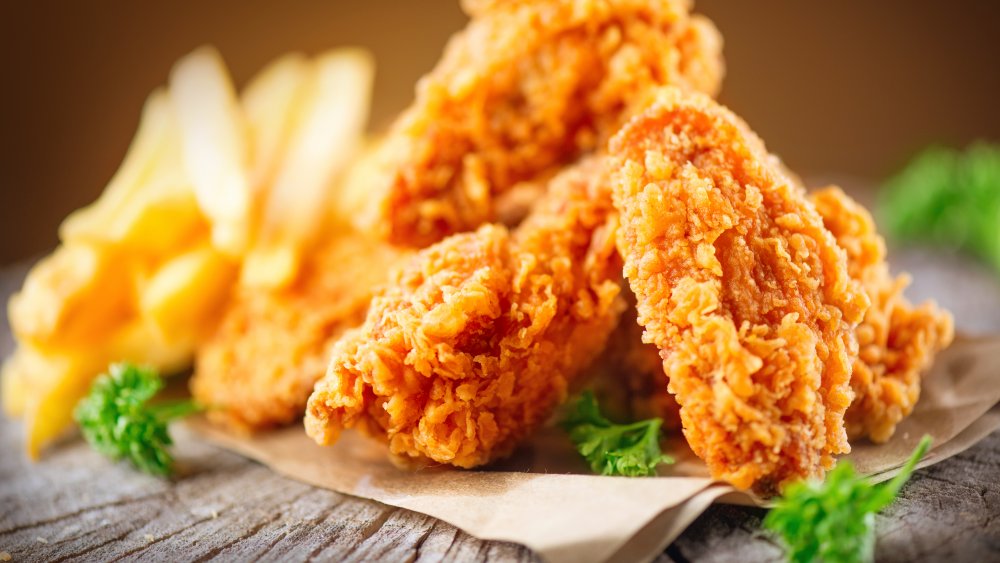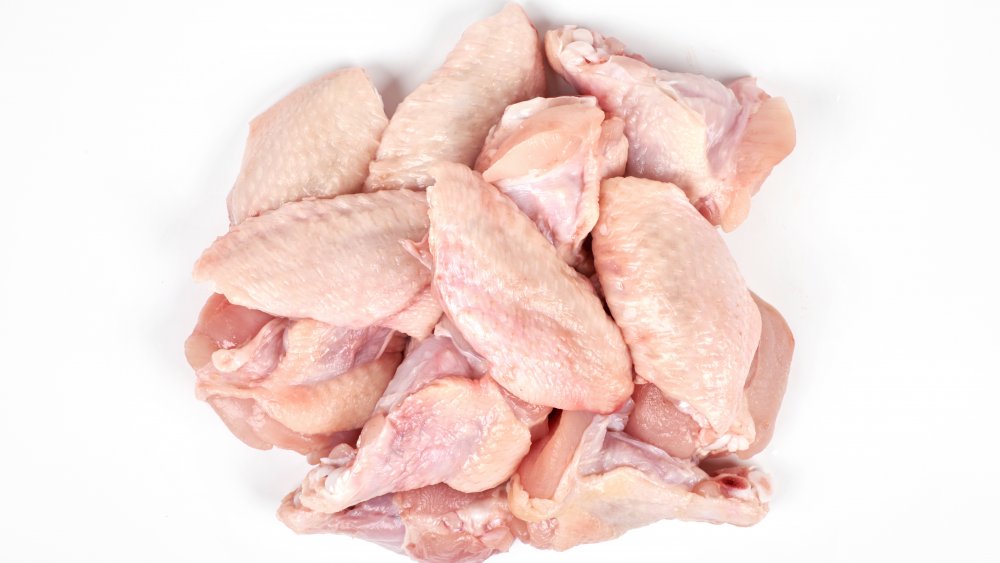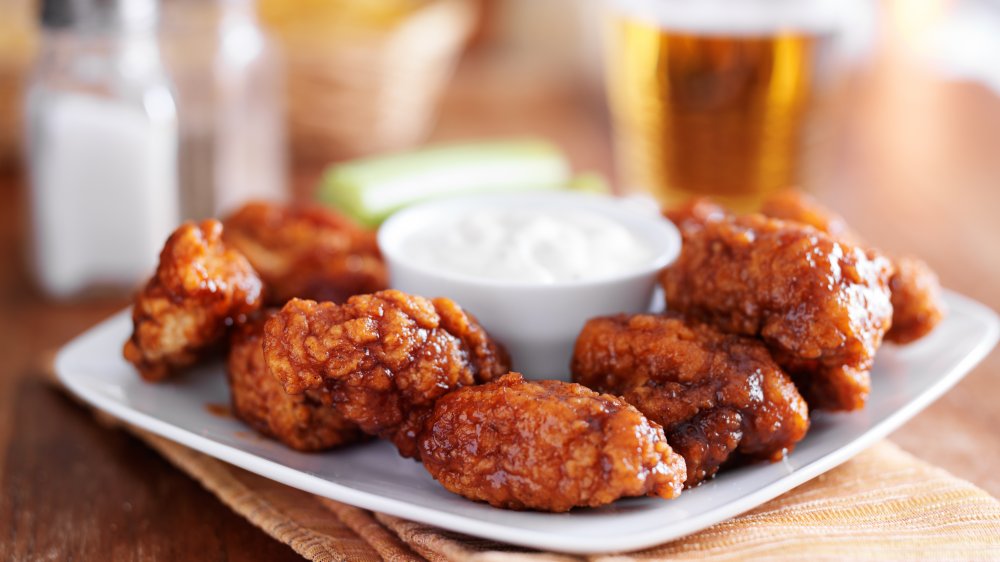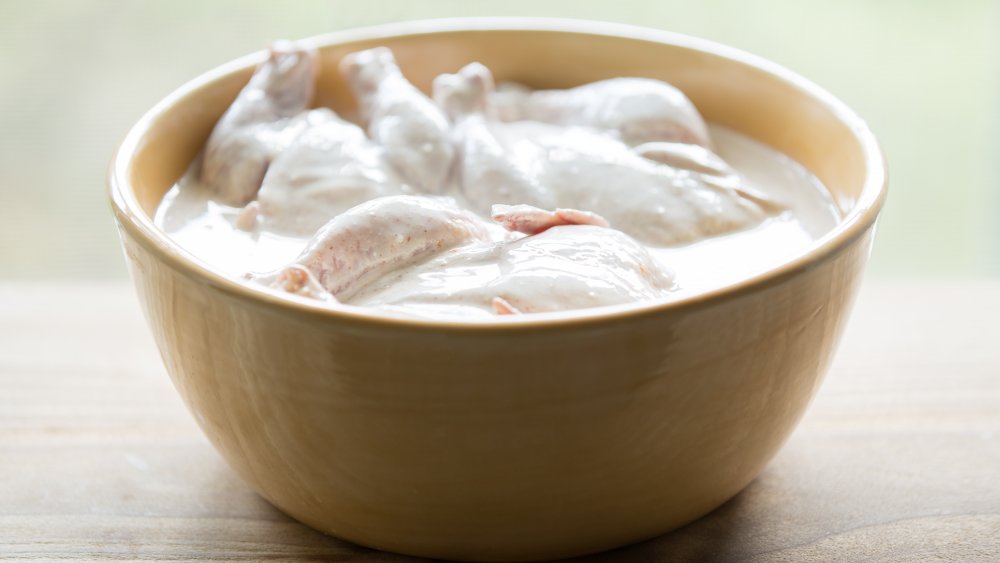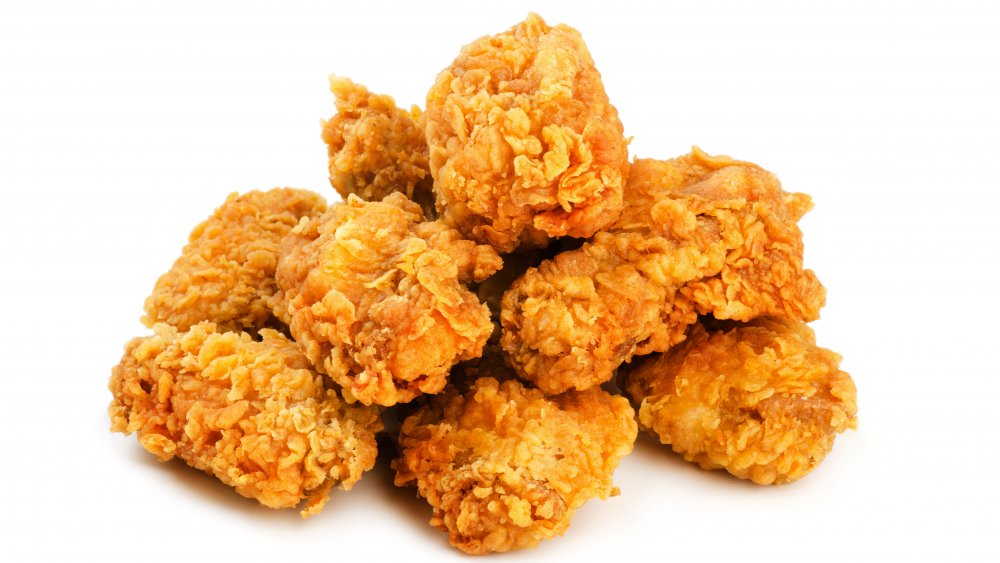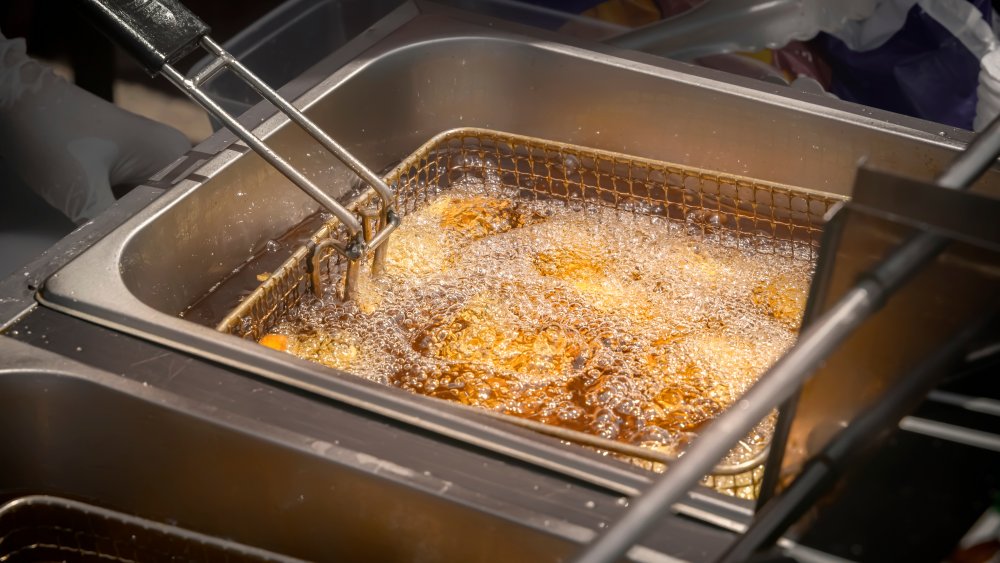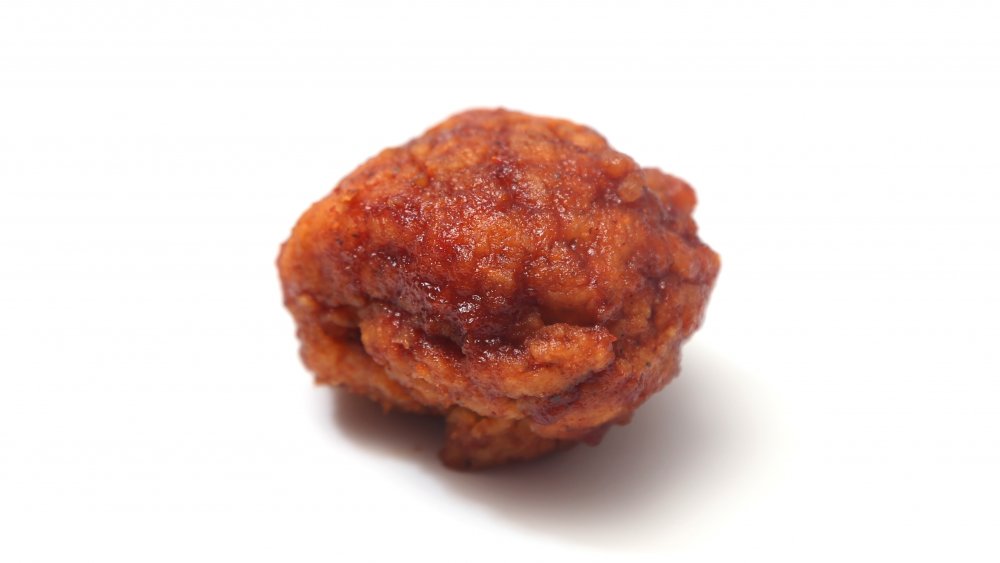Read This Before You Eat Another Boneless Wing
Americans love chicken wings. They're inexpensive and delicious, easy to share, and messy, but you can devour them without the use of a knife and fork. The National Chicken Council's 2020 annual Chicken Wing Report projected that Americans would eat nearly 1.4 billion wings on Super Bowl Sunday alone. That's enough wings to circle the Earth three times! When you consider each chicken only has two wings — each containing a drumette and a flat — it's hard to fathom how many chickens it takes to supply that kind of need. So we weren't too surprised when the Philly Voice reported in 2017 that the U.S. is in danger of running out of wings.
While the 2020 coronavirus led to the closure of restaurants and a general lack of sporting events, leaving America with a wing surplus, a new type of chicken wing stepped up to the plate to prevent any future chicken wing shortages. The boneless wing promises everything you'll find in a regular wing — juicy chicken, spicy coating, and the ability to dunk it in any number of side sauces — without the messy involvement of eating around the bone. But what exactly is a boneless wing? Is it that much different from regular bone-in wings? Read on to find out everything you need to know before you eat another boneless wing.
Boneless wings are not wings: They're technically chicken nuggets
For starters, boneless chicken wings are not really wings. Silicon Valley comedian Jimmy O. Yang summed it up best in Bon Appetit: "Boneless wings are no wings at all—they are little white meat lies." Their name implies that someone took the time to remove the bone from each wing, which sounds great in theory. The bone is the messiest part of the eating experience. Without it, you could use a fork to eat the wing meat, or just pop the entire wing straight into your mouth. Better yet, you don't have to figure out how to deal with all the trash it creates, simplifying the clean-up after tailgate parties.
Sadly, that's not the case. Instead of being a de-boned wing, boneless chicken wings are made with breast meat. The breasts are cut down into wing-sized pieces before being breaded to make them look more like a traditional wing. If you cut into a chicken wing, you'd find layers of meat, fat, cartilage, and bone. The inside of a boneless chicken wing simply yields a thick layer of white meat — just like a chicken nugget... because that's what it is.
Boneless wings contain some surprising ingredients
Traditional wings don't generally have any added ingredients. At Buffalo Wild Wings, for example, the wings come in raw and frozen. When they're thawed, the employees just toss them into the fryer as-is (according to Reddit posts from former Buffalo Wild Wing employees). Unfortunately, boneless wings don't share the same simplicity in ingredients. Because they're made from chicken breasts, they often contain several additions.
Many boneless chicken wings contain sodium phosphate — like Tyson boneless chicken wings and Digiorno Boneless Wyngz. This additive is added to deli meats and poultry products to keep the meat moist. It's generally considered safe, although its consumption is not ideal for those with kidney issues, high blood pressure, or anyone looking to reduce sodium intake. You may also find flavoring agents like calcium disodium EDTA, or binding and emulsifying agents like xanthan gum, guar gum, and propylene glycol alginate.
If you see the word transglutaminase on the ingredients list, pick another brand. This "meat glue" is used to bond proteins together. In short, this boneless wing was created with a Frankenstein-esq, pieced-together patty instead of being cut from a single chicken breast. No, thanks!
Boneless wings are less expensive than bone-in chicken wings
Over the years, the wings have become more and more popular, to the point that they're one of the most sought-after parts of the chicken. Sadly for chicken producers, they can't just breed chickens to grow extra wings — they have to raise more chickens when they want to produce more wings. That means they're also creating more chicken thighs, drumsticks, and breasts, driving down the price of once-expensive boneless skinless chicken breasts. In fact, the United States Department of Agriculture (USDA) National Retail Report showed that the price of boneless, skinless chicken breasts has dropped almost a full dollar per pound in 2020.
That means that boneless "wings" (made from chicken breasts) are a good deal for restaurants and retailers. They're able to market them as a similar product that tastes and looks the same as a regular wing. They even have the same sauce options. All the while, they're able to offer them up as a deal — like Buffalo Wild Wings' buy-one-get-one boneless wing offer — or at a discount compared to the bone-in wings. At the time of this article, a basket of 10 boneless wings at Buffalo Wild Wings was $10 as compared to the $12.99 traditional wings. That $3 savings is a good deal for you, but it's a better deal for the margins of the restaurant.
Boneless wings benefit from a brine or marinade
You don't have to do much to a chicken wing to make it taste fantastic. Simply toss it into a deep fryer or bake the wings in a high-temperature oven. The wing's skin and fat will protect the meat from drying out, creating a juicy interior. It doesn't hurt that the skin crisps up to create an addictively crunchy bite, either! Boneless wings, on the other hand, need some work to taste as good as regular wings.
Chicken breasts are naturally lean, so they don't have the wing's protective layer of fat. Instead, they need a marinade or brine to reduce moisture loss during cooking, making the boneless wings juicier and more flavorful. Some people use a classic fried chicken marinade and tenderize the boneless wings in buttermilk and salt. Others prefer brining the chicken in a basic brine ratio of 1/4 cup salt per quart (four cups) of water. Either way, boneless wings don't need long in the brine because they're cut so small, so it doesn't take much extra time to build in dryness protection.
Boneless wings need breading to look and taste like real chicken wings
When chicken wings are cooked, something called the Maillard reaction occurs. The high temperature in the oven or deep fryer crisps up the chicken skin while also turning the color a deeply appealing golden brown. But boneless wings don't have skin because they're made from boneless, skinless chicken breasts, so they need a little help to achieve the same texture and color.
That's where breading comes into play. Serious Eats explains that the breaded coating helps the boneless wings cook more gently, protecting them from burning when they contact the hot fryer oil. Meanwhile, the breading itself cooks very rapidly, drying out to become nice and crispy, just like the skin on a chicken wing. The breading can be made with seasoned flour or by using a flaky breadcrumb called panko to create an extra-crispy eating experience. Using a beer batter or tempura batter is less common with boneless wings, but you could certainly experiment and see if you like this style better when making boneless wings at home.
The best way to cook boneless wings is in a deep fryer
There is certainly some debate about the best way to cook chicken wings. Some say the deep fryer is the way to go to create a crispy-on-the-outside, juicy-on-the-inside wing. Others swear by high-temperature roasting, cooking the wings in a 425 degree Fahrenheit oven. While both methods work to create crispy wings, a deep fryer is definitely the way to go for boneless wings.
You see, deep-frying works by surrounding the food with hot oil, immediately dehydrating the exterior to form a crust. This crust prevents the oil from penetrating inside the boneless wing, keeping it from tasting too greasy. Meanwhile, the starches in the breading create a barrier between the moisture-rich chicken and the hot oil, allowing the chicken to steam inside the crispy coating. The oven (or an air fryer) also cooks the boneless chicken from the outside in, but it surrounds the breaded wings with hot air instead of hot fat. These methods still cook the boneless wings while maintaining a juicy interior, but they can't crisp up the coating as effectively as a deep fryer.
Boneless wings cook faster than bone-in wings
Have you ever noticed that chicken wings come to the table pretty quickly after you order them? That's because restaurants usually employ strategies to keep up with wing production during busy times. Chicken wings might take 10 minutes to fry in a deep fryer, or 25 minutes in the oven, but a restaurant wants to get them to your table a lot faster than that. So, cooks often partially cook the wings earlier in the day and reheat them in the fryer so they can be ready minutes after the order comes in.
With boneless wings, that par-cooking step is unnecessary because boneless wings cook faster than bone-in wings. Chicken breast meat is naturally tender when compared to wing meat, and it's also thinner and less compact — especially when it's cut into small wing-sized shapes. It will finish quicker than dark meat, cooking in roughly half the time it takes to cook bone-in wings (Epicurious estimates boneless wings take anywhere from four to six minutes).
Boneless wings can taste dry if they're not cooked properly
Although they cook faster, boneless wings are also easier to overcook, turning them into a dry, lifeless eating experience. This can happen to all types of meat — Smithsonian explains that when the meat's temperature reaches a certain point, the water inside the muscle fibers boils and evaporates. But poultry dark meat (like chicken wings) has skin and fat to protect the meat as it cooks. The fat under the skin renders and helps the meat stay juicy while the skin acts as a protective barrier to keep the wing meat from being exposed to the heat.
The breading on boneless wings functions in a similar protective way, but the lean chicken breast meat inside the boneless wing doesn't have any fat to protect it. The chicken needs to be cooked to a safe temperature of 165 degrees Fahrenheit to prevent Salmonella poisoning, but continuing to cook it past that temperature will turn the breast meat tough, dry, and chewy.
